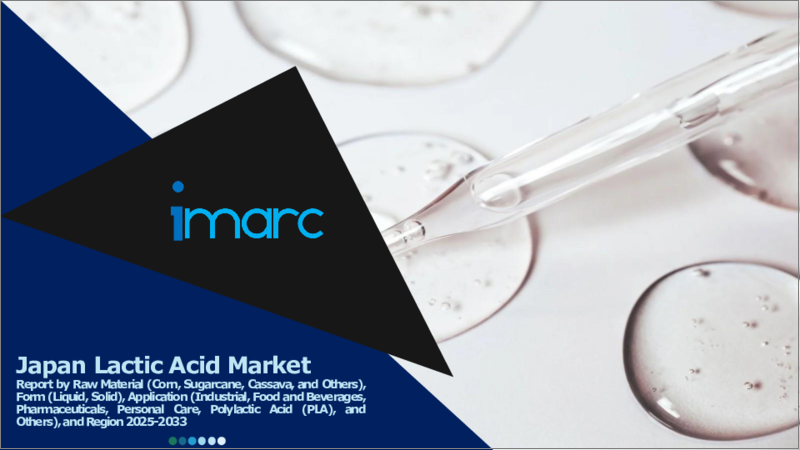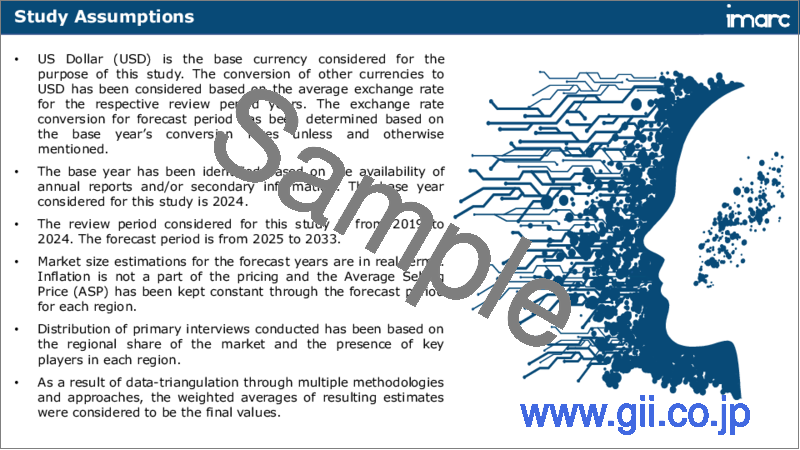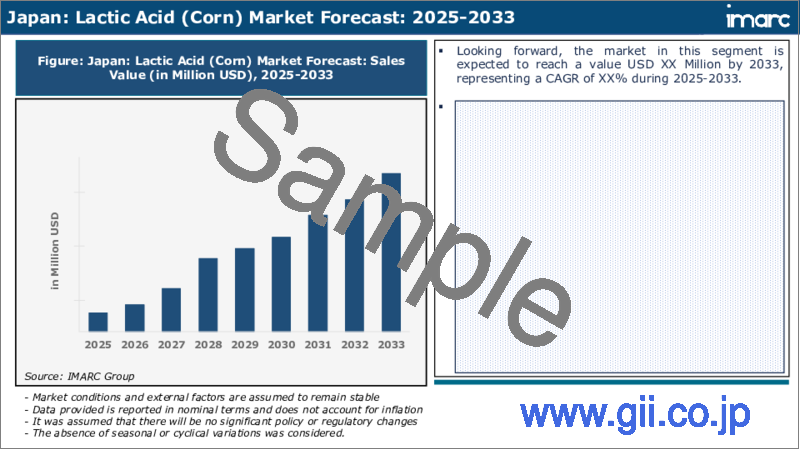|
|
市場調査レポート
商品コード
1609860
日本の乳酸市場レポート:原材料、形態、用途、地域別、2025年~2033年Japan Lactic Acid Market Report by Raw Material (Corn, Sugarcane, Cassava, and Others), Form (Liquid, Solid), Application (Industrial, Food and Beverages, Pharmaceuticals, Personal Care, Polylactic Acid (PLA), and Others), and Region 2025-2033 |
||||||
カスタマイズ可能
|
|||||||
| 日本の乳酸市場レポート:原材料、形態、用途、地域別、2025年~2033年 |
|
出版日: 2024年12月05日
発行: IMARC
ページ情報: 英文 119 Pages
納期: 5~7営業日
|
全表示
- 概要
- 目次
日本の乳酸市場の市場規模は2024年に7,730万米ドルに達しました。今後、IMARC Groupは、市場は2033年までに1億4,050万米ドルに達し、2025年から2033年にかけて6.9%の成長率(CAGR)を示すと予測しています。乳酸市場は、飲食品(F&B)分野での大幅な成長、化粧品・パーソナルケア業界での製品利用の増加、広範な研究開発(R&D)活動など、いくつかの主な要因によって顕著な拡大を経験しています。
本レポートで扱う主な質問
- 日本の乳酸市場のこれまでの業績と、今後の業績は?
- COVID-19が日本の乳酸市場に与えた影響は?
- 日本の乳酸市場の原材料別の内訳は?
- 日本の乳酸市場の形態別の内訳は?
- 日本の乳酸市場の用途別の内訳は?
- 日本の乳酸市場のバリューチェーンにはどのような段階がありますか?
- 日本乳酸の主な促進要因と課題は?
- 日本の乳酸市場の構造と主要プレーヤーは?
- 日本の乳酸市場における競合の程度は?
目次
第1章 序文
第2章 調査範囲と調査手法
- 調査の目的
- ステークホルダー
- データソース
- 市場推定
- 調査手法
第3章 エグゼクティブサマリー
第4章 日本の乳酸市場:イントロダクション
- 概要
- 市場力学
- 業界動向
- 競合情報
第5章 日本の乳酸市場情勢
- 過去および現在の市場動向(2019年~2024年)
- 市場予測(2025-2033)
第6章 日本の乳酸市場:原材料別の内訳
- トウモロコシ
- サトウキビ
- キャッサバ
- その他
第7章 日本の乳酸市場:形態別の内訳
- 液体
- 固体
第8章 日本の乳酸市場:用途別の内訳
- 産業
- 飲食品
- 医薬品
- パーソナルケア
- ポリ乳酸(PLA)
- その他
第9章 日本の乳酸市場:競合情勢
- 概要
- 市場構造
- 市場プレーヤーのポジショニング
- 主要成功戦略
- 競合ダッシュボード
- 企業評価象限
第10章 主要企業のプロファイル
第11章 日本の乳酸市場:業界分析
- 促進要因・抑制要因・機会
- ポーターのファイブフォース分析
- バリューチェーン分析
第12章 付録
Japan lactic acid market size reached USD 77.3 Million in 2024. Looking forward, IMARC Group expects the market to reach USD 140.5 Million by 2033, exhibiting a growth rate (CAGR) of 6.9% during 2025-2033. The lactic acid market is experiencing notable expansion due to several key factors, including substantial growth within the food and beverage (F&B) sector, increased utilization of the product in the cosmetic and personal care industry, and extensive research and development (R&D) activities.
Lactic acid (C3H6O3) is an organic compound that is clear and soluble in water. It occurs naturally in muscles and red blood cells. Commercially, it is derived from various raw materials, including cornstarch, sugarcane, molasses, whey, cassava, and lignocellulosic biomass. Lactic acid finds widespread application in various industries such as food and beverages, pharmaceuticals, biodegradable plastics, textiles, detergents, and personal care products. Its functions include regulating pH levels, extending shelf life, and improving the texture, flavor, and stability of products. Furthermore, lactic acid is environmentally friendly and biodegradable, contributing to reduced ecological impacts and sustainability efforts.
Japan Lactic Acid Market Trends:
The Japan lactic acid market is experiencing robust growth, driven by a multitude of factors that align with evolving industrial and consumer trends. A prominent driver is the increasing utilization of lactic acid in the pharmaceutical industry for various applications, including the production of biodegradable implants, tissue engineering scaffolds, and advanced drug delivery systems like hydrogels and nanoparticles. This diversification of product applications in healthcare contributes significantly to market expansion. Additionally, lactic acid is gaining traction as an excipient in drug formulations, where it enhances solubility and helps maintain optimal pH levels. This application adds to the market's growth momentum. The textile industry is also a significant contributor to market growth, with lactic acid finding roles in enhancing fiber properties, improving dyeing and printing processes, preventing microbial growth, and serving as a solution for removing impurities and contaminants from textile wastewater. Moreover, lactic acid has established itself in the agriculture sector, where it serves as a Biostimulants, soil conditioner, and promoter of plant growth, further contributing to market expansion. It is also utilized in animal feed as an acidifier and preservative, promoting beneficial gut bacteria and improving nutrient absorption. Other factors such as increasing demand for environmentally friendly products, easy availability of lactic acid through online retail platforms, and emerging health and wellness trends among consumers are expected to further drive the growth of the Japan lactic acid market in the coming years.
Japan Lactic Acid Market Segmentation:
Raw Material Insights:
- Corn
- Sugarcane
- Cassava
- Others
Form Insights:
- Liquid
- Solid
Application Insights:
- Industrial
- Food and Beverages
- Pharmaceuticals
- Personal Care
- Polylactic Acid (PLA)
- Others
Competitive Landscape:
The market research report has also provided a comprehensive analysis of the competitive landscape. Competitive analysis such as market structure, key player positioning, top winning strategies, competitive dashboard, and company evaluation quadrant has been covered in the report. Also, detailed profiles of all major companies have been provided. Some of the key players include:
- Galactic
- Kameda Seika Co. Ltd.
- Musashino Chemical Laboratory Ltd.
Key Questions Answered in This Report:
- How has the Japan lactic acid market performed so far and how will it perform in the coming years?
- What has been the impact of COVID-19 on the Japan lactic acid market?
- What is the breakup of the Japan lactic acid market on the basis of raw material?
- What is the breakup of the Japan lactic acid market on the basis of form?
- What is the breakup of the Japan lactic acid market on the basis of application?
- What are the various stages in the value chain of the Japan lactic acid market?
- What are the key driving factors and challenges in the Japan lactic acid?
- What is the structure of the Japan lactic acid market and who are the key players?
- What is the degree of competition in the Japan lactic acid market?
Table of Contents
1 Preface
2 Scope and Methodology
- 2.1 Objectives of the Study
- 2.2 Stakeholders
- 2.3 Data Sources
- 2.3.1 Primary Sources
- 2.3.2 Secondary Sources
- 2.4 Market Estimation
- 2.4.1 Bottom-Up Approach
- 2.4.2 Top-Down Approach
- 2.5 Forecasting Methodology
3 Executive Summary
4 Japan Lactic Acid Market - Introduction
- 4.1 Overview
- 4.2 Market Dynamics
- 4.3 Industry Trends
- 4.4 Competitive Intelligence
5 Japan Lactic Acid Market Landscape
- 5.1 Historical and Current Market Trends (2019-2024)
- 5.2 Market Forecast (2025-2033)
6 Japan Lactic Acid Market - Breakup by Raw Material
- 6.1 Corn
- 6.1.1 Overview
- 6.1.2 Historical and Current Market Trends (2019-2024)
- 6.1.3 Market Forecast (2025-2033)
- 6.2 Sugarcane
- 6.2.1 Overview
- 6.2.2 Historical and Current Market Trends (2019-2024)
- 6.2.3 Market Forecast (2025-2033)
- 6.3 Cassava
- 6.3.1 Overview
- 6.3.2 Historical and Current Market Trends (2019-2024)
- 6.3.3 Market Forecast (2025-2033)
- 6.4 Others
- 6.4.1 Historical and Current Market Trends (2019-2024)
- 6.4.2 Market Forecast (2025-2033)
7 Japan Lactic Acid Market - Breakup by Form
- 7.1 Liquid
- 7.1.1 Overview
- 7.1.2 Historical and Current Market Trends (2019-2024)
- 7.1.3 Market Forecast (2025-2033)
- 7.2 Solid
- 7.2.1 Overview
- 7.2.2 Historical and Current Market Trends (2019-2024)
- 7.2.3 Market Forecast (2025-2033)
8 Japan Lactic Acid Market - Breakup by Application
- 8.1 Industrial
- 8.1.1 Overview
- 8.1.2 Historical and Current Market Trends (2019-2024)
- 8.1.3 Market Forecast (2025-2033)
- 8.2 Food and Beverages
- 8.2.1 Overview
- 8.2.2 Historical and Current Market Trends (2019-2024)
- 8.2.3 Market Forecast (2025-2033)
- 8.3 Pharmaceuticals
- 8.3.1 Overview
- 8.3.2 Historical and Current Market Trends (2019-2024)
- 8.3.3 Market Forecast (2025-2033)
- 8.4 Personal Care
- 8.4.1 Overview
- 8.4.2 Historical and Current Market Trends (2019-2024)
- 8.4.3 Market Forecast (2025-2033)
- 8.5 Polylactic Acid (PLA)
- 8.5.1 Overview
- 8.5.2 Historical and Current Market Trends (2019-2024)
- 8.5.3 Market Forecast (2025-2033)
- 8.6 Others
- 8.6.1 Historical and Current Market Trends (2019-2024)
- 8.6.2 Market Forecast (2025-2033)
9 Japan Lactic Acid Market - Competitive Landscape
- 9.1 Overview
- 9.2 Market Structure
- 9.3 Market Player Positioning
- 9.4 Top Winning Strategies
- 9.5 Competitive Dashboard
- 9.6 Company Evaluation Quadrant
10 Profiles of Key Players
- 10.1 Galactic
- 10.1.1 Business Overview
- 10.1.2 Product Portfolio
- 10.1.3 Business Strategies
- 10.1.4 SWOT Analysis
- 10.1.5 Major News and Events
- 10.2 Kameda Seika Co. Ltd.
- 10.2.1 Business Overview
- 10.2.2 Product Portfolio
- 10.2.3 Business Strategies
- 10.2.4 SWOT Analysis
- 10.2.5 Major News and Events
- 10.3 Musashino Chemical Laboratory Ltd.
- 10.3.1 Business Overview
- 10.3.2 Product Portfolio
- 10.3.3 Business Strategies
- 10.3.4 SWOT Analysis
- 10.3.5 Major News and Events
Please note that this is only a partial list of the key players, and the complete list is provided in the report.
11 Japan Lactic Acid Market - Industry Analysis
- 11.1 Drivers, Restraints, and Opportunities
- 11.1.1 Overview
- 11.1.2 Drivers
- 11.1.3 Restraints
- 11.1.4 Opportunities
- 11.2 Porters Five Forces Analysis
- 11.2.1 Overview
- 11.2.2 Bargaining Power of Buyers
- 11.2.3 Bargaining Power of Suppliers
- 11.2.4 Degree of Competition
- 11.2.5 Threat of New Entrants
- 11.2.6 Threat of Substitutes
- 11.3 Value Chain Analysis






